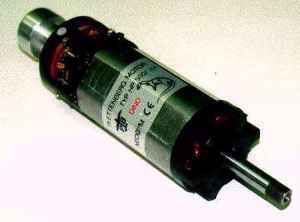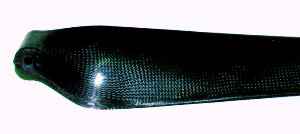During development of the Solair II many innovative
concepts were put into practice for the first time. Consequently,
the Solair II is much more than just a motorized glider with
electric propulsion and a solar generator. The design of the
structural elements introduces totally new ideas. Apart from
consistently implementing state-of-the-art technologies, the
integration of substantial secondary functions leads to further
weight reductions and simplifies assembly and operation. The
Solair II control surface hinges are presented here for an
example:
The filaments of the composite structure (both wing/stab and
control surface alike) are wrapped around 30 mm pieces of
aluminum tube located at the pivot center. A steel wire runs
inside the aluminum tubes, connecting the control surface to the
wing or stab. This way, the hinge covers the whole length, seals
the gap and effectively combines minimum weight with maximum
strength: the steel wire cross section takes the shear load every
30 mm.

Integrated into the composite structure, the hinge is
economically built together with the main part in the negative
mold.
All parts to be assembled at the flying field have a form fit
to improve reliability and minimize maintenance efforts.
Subassemblies are automatically secured by spring loaded locking
bolts. Assembly is as simple as pressing in the spring bolts and
pushing the parts together. As soon as the bolts engage, proper
fit and locking is ensured. Also, there is no need to manually
connect and secure links etc. - all control linkages and
electrical connections are automatic. Control surfaces in the
wing and stab are driven centrally from the fuse by torsion
elements. This eliminates links and joints in the wing and stab.

All parts of the Solair II are connected by a form
fit. Spring loaded locking bolts make for a safe and simple
latch.
New methods are pursued in mounting the solar cells too. First of all, an optimized soldering process reduces the cell links to ½ the usual thickness. This in turn allows for embedding the generator in a much thinner fibreglass assembly. The back of the generator is padded with Rohacell foam for an optimum fit to the underlying structure as well as thermal isolation. This is especially important in order to avoid overheating the wing and stab structure from intense solar radiation. The generator segments are mounted to the wing top surface by a form fit and can be serviced and replaced individually and easily. An elaborated compensation scheme guarantees that the wing can bend freely under the generator segments without stressing the sensitive solar cells.
Furthermore, quite a few electronic devices and components were designed and built specifically for the Solair II. Here as well as with numerous other components, the know-how of many specialists was tapped successfully.
For example, PCE-Solartechnik designed the solar charge controller Optimizer which - under greatly varying insolation - transfers that precious solar energy to the batteries and motor controller with an efficiency of 98 % while at the same time ensuring that the solar cells are operated at their MPP (Maximum Power Point).
The motor controller was developed in a cooperation between Albrecht Elektronik and Ing.-Büro Schoder specially for the Solair II. The goal was to regulate the high potential power - currents up to 180 Ampere during the start phase - with minimal losses and sensitive control. Another point was to optimize operational safety and fault tolerance. The computerized controller guards against unintentional starting of the motors - an important safety aspect. Soft start, adjustable brake and reliable overload protection for motors and electronics complete the feature list.
Other specialists were called in to design the propulsion
unit. The motors and propellers are the result of a team effort
among well-known model airplane experts. Only careful
optimization and matching of all components made those high
efficiencies a reality.


The propulsion unit was developed by a joint effort of model airplane experts. Matching the individual components was the major challenge here.